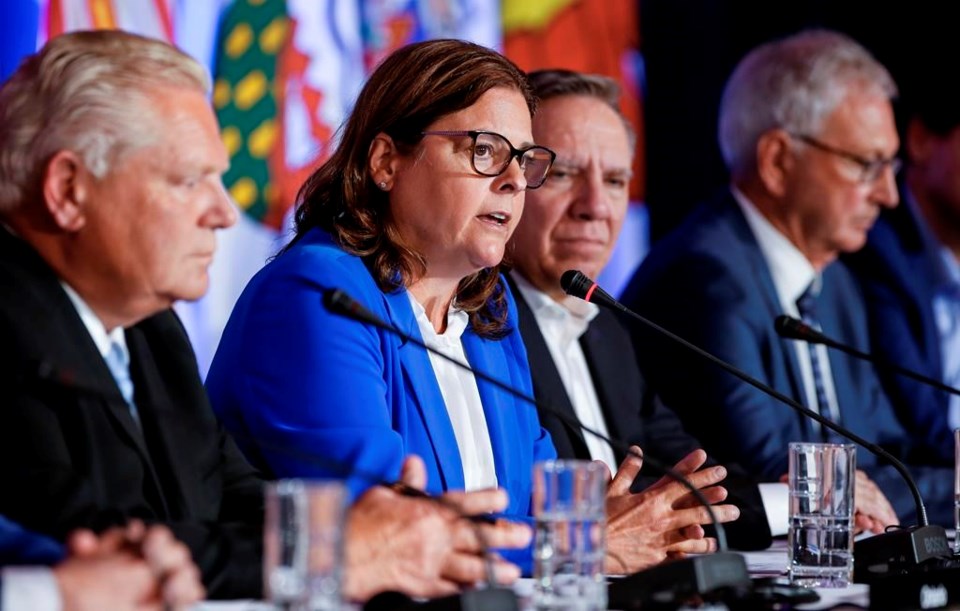WINNIPEG — Despite her 23 years as a politician — and almost two as Manitoba's first female premier — Heather Stefanson says she is still getting used to the public spotlight. She is more accustomed to working in the background.
"I'm not someone that seeks attention. I like to get things done," Stefanson said in an interview.
"I've always been ... a little bit of a behind-the-scenes kind of person. So I think that spotlight is not something I'm used to. It's not something I seek out. And I think that has been challenging for me because it's just not something that comes naturally to me."
Stefanson, 53, was seven years old when she got her first taste of politics. Her father ran for a seat in the legislature, finishing second to Liberal Lloyd Axworthy.
She studied political science at university and later worked for Mila Mulroney, whose husband, Brian Mulroney, was prime minister at the time.
While in Ottawa, she met her future husband, Jason Stefanson, a nephew of a former Manitoba cabinet minister. They have two children.
Stefanson became an investment adviser in the 1990s and almost got away from politics, but then long-serving Progressive Conservative premier Gary Filmon resigned his legislature seat after losing the 1999 election. Stefanson got the Tory nomination, ran in a byelection the following year and has held the Tuxedo seat in Winnipeg ever since.
Stefanson spent years on the opposition benches and, when the Tories won the 2016 election, got appointed to cabinet. She held a variety of portfolios including families, justice and health. When former premier Brian Pallister resigned in 2021, Stefanson ran for party leader, got the backing of big names in the Tory establishment and narrowly beat her rival, Shelly Glover.
She set out to differentiate herself from Pallister when she took over the Tories, whose popular support at that time dropped sharply in opinion polls. She promised a more conciliatory approach. She scrapped a plan to eliminate elected school boards that had been met with widespread public opposition.
But her time in office has included controversy, and recent polls suggest that while the Tories have seen a bit of a rebound, they continue to trail the NDP in Winnipeg, where most legislature seats are.
While running for the Tory leadership, Stefanson, who had been health minister during some of the darkest days of the COVID-19 pandemic, was asked in a CBC interview why she didn't push for tighter public health rules. She responded by saying the government was working in a fast-changing environment and used the phrase "coulda, shoulda, woulda" in describing hindsight.
A few months after she became premier, she faced a query from the NDP in question period about the death of a COVID-19 patient. Stefanson began her response with remarks congratulating her son's hockey team for having won a provincial championship the previous day.
Her remarks were quickly denounced by critics and on social media, and she apologized.
She says she has learned from such instances.
"I think we learn from our mistakes and no one is perfect."
One political analyst says Stefanson has become more disciplined in her messaging, and is someone who may not deliver a fiery speech but can discuss policy well.
"Heather is not someone who is going to light the lectern on fire, and I think she knows that," said Royce Koop, who teaches political studies at the University of Manitoba.
"The advantage that she has is she's disciplined. I think she takes advice really well and sticks with it."
Stefanson also has strong organizational abilities from her years of working in the background, Koop said.
Those skills have led to the return of some people who had left party or government circles under Pallister, including Sanford Riley, who had resigned as board chair of Manitoba Hydro. Stefanson brought him back as an adviser.
Stefanson's more conciliatory approach has not extended to all areas, however. She said in 2021 the province was dropping a court battle with the federal government over Ottawa's decision to impose carbon pricing in Manitoba. However, she recently promised to go to court again to try to get the federal levy off of Manitoba natural gas bills.
Stefanson had also promised to work more collaboratively with Indigenous communities. But the Assembly of Manitoba Chiefs has called for her to resign because she has rejected demands to search a landfill north of Winnipeg where the remains of two First Nations women are believed to be.
When asked what she would consider as a mark of a successful full term as premier, Stefanson cited economic growth that would generate opportunities for people, as well as money for front-line programs.
"I think growing our economy is going to be key," Stefanson said.
"What that means is that there's more money for health care, education, social services (and) making life more affordable for Manitobans."
This report by The Canadian Press was first published Sept. 5, 2023.
Steve Lambert, The Canadian Press



